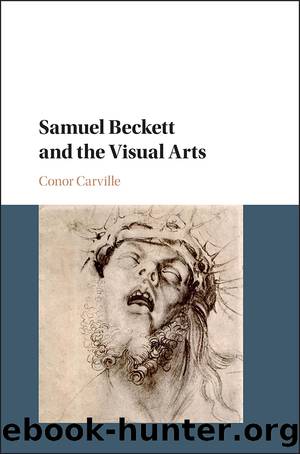Samuel Beckett and the Visual Arts by Carville Conor

Author:Carville, Conor
Language: eng
Format: epub
Publisher: Cambridge University Press
Published: 2018-02-27T00:00:00+00:00
Note that Beckett does not examine a specific picture, but essays a more general description of technique: âthe way he puts down a manâs head and a womanâs head, side by sideâ. Such a description suggests a signature procedure on Yeatsâ part, and that seems to be Beckettâs intention â to assert a style or tactic that will form the material basis for his reading of the whole oeuvre. There is no possibility of relationship between the individuals in this generic Yeats painting; they are â2 entities that will never mingleâ. And yet there is a very strong relationship between the viewer and the painting, one that Beckett sees created by Yeatsâ distinctive formal tactic of juxtaposition. Thus Yeats depicts the âimpassible immensityâ between his characters, but in doing so supplies what Beckett calls a âpetrified insight into oneâs own hard, irreducible singlenessâ. âPetrified insightâ: this phrase is from the Sinclair letter; in the equivalent letter to MacGreevy, the word âpetrifiedâ is applied not to the beholderâs insight, but only to describe the âstillnessâ of the painting itself. Petrification occurs on both sides of the divide between painting and beholder then, and in each case seems to mean a certain kind of stillness. This stillness of the painting comes about because of the âimpassible immensityâ between the two characters depicted, for such a breach reveals the impossibility of social exchange, of âthe performance of love & hate, joy and painâ between them. Yet this materialized impasse also stills the beholder, shocking them with this assertion of radical isolation. The notion of petrification has connotations of mineralization and the inorganic, of course, and there is thus a strong sense here of the painting actually freezing the viewer, rendering them dead. But most importantly, Beckett is also thinking here of Leibniz: the âhard, irreducible singlenessâ experienced is that of the monad.
These are very radical claims to make for painting, a token of the profound respect that Beckett had for Yeats. They are part of a concerted effort to think about art in terms that do not retreat back into either a modernist rhetoric of vitalist immediacy, or a standard neo-Kantian dualistic model. And yet, as with earlier moments in Beckettâs aesthetic thought, there are traces of both these positions. His accounts of both Yeats and Watteau actively depend on the establishment of a formal distance between the beholder as subject and the painting as object. There is no fusion, no âpure optical experienceâ ruffling the molecules of the retina or brain. What we have instead is what Beckett calls Yeatsâ âdispassionate perceptionâ, a disenchanted recognition of the impossibility of relation. And yet even so there is a clear emphasis on a kind of substantial immediacy between object and beholder, a common ground in the mutual petrification that takes place. It is as if the vitalist view of the world as a dance that elides the subject-object distinction is reworked as a calcification or congealing that is the real condition of all being. This is the stillness that Beckett speaks of.
Download
This site does not store any files on its server. We only index and link to content provided by other sites. Please contact the content providers to delete copyright contents if any and email us, we'll remove relevant links or contents immediately.
Phoenicians among Others: Why Migrants Mattered in the Ancient Mediterranean by Denise Demetriou(577)
Verus Israel: Study of the Relations Between Christians and Jews in the Roman Empire, AD 135-425 by Marcel Simon(576)
Caesar Rules: The Emperor in the Changing Roman World (c. 50 BC â AD 565) by Olivier Hekster(558)
Europe, Strategy and Armed Forces by Sven Biscop Jo Coelmont(504)
american english file 1 student book 3rd edition by Unknown(481)
Give Me Liberty, Seventh Edition by Foner Eric & DuVal Kathleen & McGirr Lisa(469)
Banned in the U.S.A. : A Reference Guide to Book Censorship in Schools and Public Libraries by Herbert N. Foerstel(467)
The Roman World 44 BC-AD 180 by Martin Goodman(458)
Reading Colonial Japan by Mason Michele;Lee Helen;(457)
Basic japanese A grammar and workbook by Unknown(456)
DS001-THE MAN OF BRONZE by J.R.A(443)
The Dangerous Life and Ideas of Diogenes the Cynic by Jean-Manuel Roubineau(440)
Introducing Christian Ethics by Samuel Wells and Ben Quash with Rebekah Eklund(433)
Imperial Rome AD 193 - 284 by Ando Clifford(432)
The Oxford History of World War II by Richard Overy(432)
Literary Mathematics by Michael Gavin;(392)
Language Hacking Mandarin by Benny Lewis & Dr. Licheng Gu(380)
Catiline by Henrik Ibsen--Delphi Classics (Illustrated) by Henrik Ibsen(369)
How to Reach the 9.0 in IELTS Academic Reading by IELTS Medical(358)
